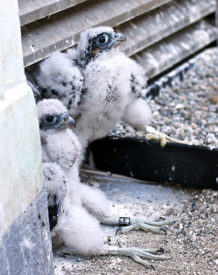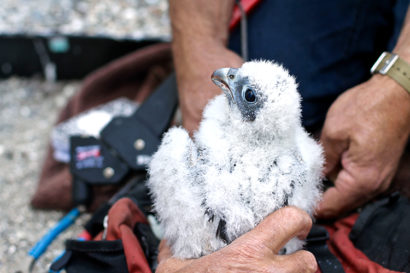Bird-safe streamers in place, peregrine falcon Fiat to leave any day
After peregrine falcon Lux flew into a window on campus and died last month, experts have installed bird-safe streamers to prevent another accident
August 4, 2017
After peregrine falcon Lux — one of two chicks born on UC Berkeley’s Campanile in May — flew into a window on campus and died last month, experts have installed bird-safe streamers to prevent another accident.
Lux, so named by the campus community in a Facebook survey, had only been flying a week when she got trapped on a 10th-floor balcony of Evans Hall. In her attempt to escape, she flew into a window and died from the impact.
Berkeley News spoke with Mary Malec, a volunteer raptor nest monitor with the East Bay Regional Park District, who worked with Doug Bell, the wildlife program manager of the East Bay Regional Park District, and the campus to install the streamers in Evans Hall.
Where did you install the bird-safe streamers?
Bird-safe streamers went up on the 10th-floor east and west balconies of Evans Hall last week. We found that most of the windows already had non-glare film over them, so only the end windows needed the streamers. No other buildings seemed to need them. I thought Stanley might, but when we were on the Evans balcony, we could see that all the windows in Stanley have drapes. [Drawing blinds and curtains, or hanging fluttery objects in front of windows, is another way to prevent accidental collisions.]

The campus hung bird-safe streamers on the 10th-floor east and west balconies of Evans Hall. (UC Berkeley photo by Maria Garcia-Alvarez)
Berkeley News: What bird-safe options did you consider installing?
Mary Malec: We looked at decals and streamers. To be effective, the texture or pattern needs to be less than four inches apart. The spacing of the paracord is for small birds, but works equally well to deter raptors. Glass with texture and pattern is being used on new construction for large glass surfaces. For existing glass, streamers are most effective. Long strips of paracord were attached to the windows on Evans as a deterrent. The intent is twofold: To visually break up the expanse of glass so passerines [smaller birds that perch] know there is no passage through and the streamers move in the wind in this installation because they are out on the deck.
Fiat — Lux’s sibling — could leave the area any day now. Do you know when the juvenile is likely to move on?
Fiat is still around. Juveniles stay in the area for a period of several weeks to several months. Most have left by the time they’ve been out flying for six to eight weeks. He/she could stay for another month or might leave anytime.
Recently, Fiat’s gender has come into question. Can you explain why?
When a bird is banded, the tarsus (ankle bone where the band is placed) is measured to determine the correct band size. Banding is done in the nest when the bird’s leg is full grown, so the band will fit it forever, but when the bird is still young enough that it doesn’t have enough feather development to get away or accidentally fly off the nest ledge. For peregrines, if the band size is 7A or bigger, it is called a female. If it is a 6, it is called a male. [Male peregrines are smaller than females.] When all banders follow the convention, data is standardized. Both of the chick’s legs measured 7A at banding.

Peregrine chicks Lux (left) and Fiat, about a month old, after they were banded in June (Photo by Mary Malec)
However, there are sometimes large males and small females. And you never know for sure until you encounter a breeding bird. But if you follow the standard, most of the time you are correct. Fiat fledged within the window of time a male usually first flies, between 39 to 41 days of age. Lux fledged within the window of time a female usually first flies at 42 to 44 days old. Males are smaller and have less mass to hold up with their wings’ muscles, so they can fly earlier.
Ultimately, Fiat will know its gender. It doesn’t care what it’s called.
Will Fiat come back to the Campanile?
It is not likely that Fiat will return. If Fiat returned as an adult, she would be viewed as an intruder adult and would be chased out of the territory.
Where will Fiat go?
Band recovery data from various parts of the world have been analyzed to look at dispersal of juvenile peregrines. Data show that females disperse an average of 50 miles and males go about 30 miles from their natal area. Peregrines have been reported several hundred miles from their birthplace so anything from a few miles to many hundreds of miles is possible.
Will the two adult peregrines stay on the Campanile year-round?
It is likely that this pair will remain. Local peregrines are non-migratory and stay in their territories year-round. For those that do migrate, they return to their territory to breed. If one dies, the remaining peregrine would stay in the territory and the other would be replaced by a floater (a non-breeding adult looking for a territory). We get wintering migrants coming to the area. In fact, in many years we’ve seen wintering peregrines on the Campanile. Territorial adults are less defensive of their territory in the winter and do not chase off every adult as aggressively as they do during breeding season.
What other birds can we see on campus?
Red shouldered hawks, several other peregrines passing by, acorn woodpeckers, ravens and crows, jays, nuthatches, Anna’s hummingbirds, swallows, mourning doves, chickadees, starlings, waxwings, sparrows, robins, California towhees and many others.
Learn more about the campus’s first peregrine family on Berkeley News.


